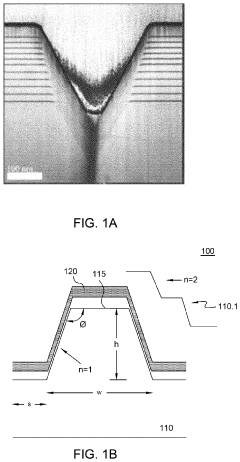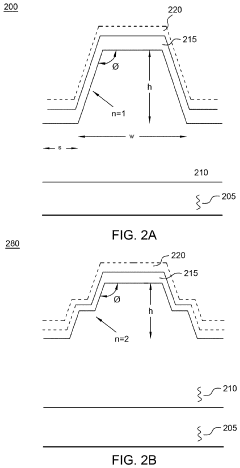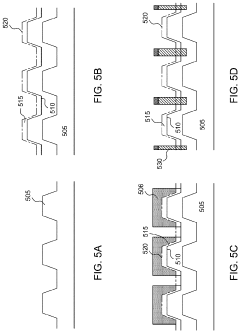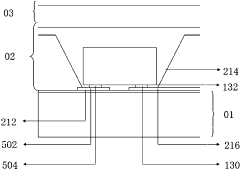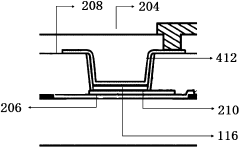How to Advance ULED Through Strategic Partnerships?
JUN 20, 20259 MIN READ
Generate Your Research Report Instantly with AI Agent
Patsnap Eureka helps you evaluate technical feasibility & market potential.
ULED Technology Evolution and Objectives
Ultra-Light Emitting Diode (ULED) technology has emerged as a promising advancement in the field of display and lighting solutions. The evolution of ULED can be traced back to the development of LED technology, which has undergone significant improvements over the past few decades. ULED represents a leap forward in terms of energy efficiency, brightness, and color accuracy, making it a focal point for research and development in the display industry.
The primary objective of ULED technology is to overcome the limitations of traditional LED displays while maintaining cost-effectiveness and scalability. This includes achieving higher luminance levels, improved color gamut, and enhanced contrast ratios. Additionally, ULED aims to reduce power consumption and heat generation, addressing two critical challenges in modern display technologies.
As the display market continues to evolve, ULED technology is positioned to meet the growing demand for high-quality, energy-efficient displays across various applications. From consumer electronics to automotive displays and large-scale outdoor signage, ULED has the potential to revolutionize visual experiences.
The technological trajectory of ULED is closely linked to advancements in materials science and manufacturing processes. Researchers are exploring novel semiconductor materials and nanostructures to enhance the performance of ULED devices. Quantum dot technology, for instance, has shown promise in improving color accuracy and expanding the color gamut of ULED displays.
Strategic partnerships play a crucial role in advancing ULED technology. Collaborations between display manufacturers, material suppliers, and research institutions are essential for driving innovation and overcoming technical challenges. These partnerships can accelerate the development of new ULED architectures, improve manufacturing techniques, and facilitate the integration of ULED technology into diverse applications.
The future objectives for ULED technology include further miniaturization of diode structures, increased pixel density, and improved light extraction efficiency. Researchers are also focusing on developing flexible and transparent ULED displays, opening up new possibilities for wearable devices and augmented reality applications.
As ULED technology continues to mature, industry leaders are setting ambitious targets for brightness, contrast ratio, and color accuracy. The goal is to surpass the performance of OLED and other competing display technologies while maintaining the advantages of LED-based systems, such as longer lifespan and resistance to burn-in effects.
The primary objective of ULED technology is to overcome the limitations of traditional LED displays while maintaining cost-effectiveness and scalability. This includes achieving higher luminance levels, improved color gamut, and enhanced contrast ratios. Additionally, ULED aims to reduce power consumption and heat generation, addressing two critical challenges in modern display technologies.
As the display market continues to evolve, ULED technology is positioned to meet the growing demand for high-quality, energy-efficient displays across various applications. From consumer electronics to automotive displays and large-scale outdoor signage, ULED has the potential to revolutionize visual experiences.
The technological trajectory of ULED is closely linked to advancements in materials science and manufacturing processes. Researchers are exploring novel semiconductor materials and nanostructures to enhance the performance of ULED devices. Quantum dot technology, for instance, has shown promise in improving color accuracy and expanding the color gamut of ULED displays.
Strategic partnerships play a crucial role in advancing ULED technology. Collaborations between display manufacturers, material suppliers, and research institutions are essential for driving innovation and overcoming technical challenges. These partnerships can accelerate the development of new ULED architectures, improve manufacturing techniques, and facilitate the integration of ULED technology into diverse applications.
The future objectives for ULED technology include further miniaturization of diode structures, increased pixel density, and improved light extraction efficiency. Researchers are also focusing on developing flexible and transparent ULED displays, opening up new possibilities for wearable devices and augmented reality applications.
As ULED technology continues to mature, industry leaders are setting ambitious targets for brightness, contrast ratio, and color accuracy. The goal is to surpass the performance of OLED and other competing display technologies while maintaining the advantages of LED-based systems, such as longer lifespan and resistance to burn-in effects.
Market Demand Analysis for ULED Displays
The market demand for ULED (Ultra Light Emitting Diode) displays has been experiencing significant growth in recent years, driven by the increasing need for high-quality, energy-efficient display technologies across various industries. ULED technology offers superior picture quality, enhanced brightness, and improved color accuracy compared to traditional LED displays, making it an attractive option for consumers and businesses alike.
In the consumer electronics sector, ULED displays are gaining traction in high-end televisions and monitors. The demand for larger screen sizes with 4K and 8K resolutions is fueling the adoption of ULED technology, as it provides better contrast ratios and deeper blacks than conventional LED displays. This trend is particularly evident in markets such as North America, Europe, and Asia-Pacific, where consumers are willing to invest in premium display technologies for immersive viewing experiences.
The commercial sector is another key driver of ULED display demand. Digital signage applications, including outdoor advertising, retail displays, and information boards, are increasingly adopting ULED technology for its superior brightness and visibility in various lighting conditions. The ability of ULED displays to deliver vibrant, eye-catching content even in bright outdoor environments makes them ideal for these applications.
The automotive industry is also showing growing interest in ULED displays for in-vehicle infotainment systems and digital dashboards. As vehicles become more connected and autonomous, the demand for high-quality, responsive displays is rising. ULED technology's ability to provide clear, bright visuals in varying light conditions makes it well-suited for automotive applications.
In the healthcare sector, ULED displays are finding applications in medical imaging and diagnostic equipment. The technology's high contrast ratio and color accuracy are valuable for viewing detailed medical images, potentially improving diagnostic accuracy and patient outcomes.
Market research indicates that the global ULED display market is expected to grow at a compound annual growth rate (CAGR) of over 15% from 2021 to 2026. This growth is attributed to increasing consumer demand for high-quality displays, technological advancements in display manufacturing, and the expanding application areas for ULED technology.
However, challenges remain in the widespread adoption of ULED displays. The higher cost of production compared to traditional LED displays is a significant barrier, particularly in price-sensitive markets. Additionally, competition from other emerging display technologies, such as OLED and MicroLED, poses a challenge to ULED market growth.
To advance ULED through strategic partnerships, companies should focus on collaborations that address these challenges. Partnerships with material suppliers and manufacturing equipment providers could help reduce production costs and improve yield rates. Collaborations with content creators and streaming platforms could drive the development of ULED-optimized content, showcasing the technology's capabilities and increasing consumer demand.
In the consumer electronics sector, ULED displays are gaining traction in high-end televisions and monitors. The demand for larger screen sizes with 4K and 8K resolutions is fueling the adoption of ULED technology, as it provides better contrast ratios and deeper blacks than conventional LED displays. This trend is particularly evident in markets such as North America, Europe, and Asia-Pacific, where consumers are willing to invest in premium display technologies for immersive viewing experiences.
The commercial sector is another key driver of ULED display demand. Digital signage applications, including outdoor advertising, retail displays, and information boards, are increasingly adopting ULED technology for its superior brightness and visibility in various lighting conditions. The ability of ULED displays to deliver vibrant, eye-catching content even in bright outdoor environments makes them ideal for these applications.
The automotive industry is also showing growing interest in ULED displays for in-vehicle infotainment systems and digital dashboards. As vehicles become more connected and autonomous, the demand for high-quality, responsive displays is rising. ULED technology's ability to provide clear, bright visuals in varying light conditions makes it well-suited for automotive applications.
In the healthcare sector, ULED displays are finding applications in medical imaging and diagnostic equipment. The technology's high contrast ratio and color accuracy are valuable for viewing detailed medical images, potentially improving diagnostic accuracy and patient outcomes.
Market research indicates that the global ULED display market is expected to grow at a compound annual growth rate (CAGR) of over 15% from 2021 to 2026. This growth is attributed to increasing consumer demand for high-quality displays, technological advancements in display manufacturing, and the expanding application areas for ULED technology.
However, challenges remain in the widespread adoption of ULED displays. The higher cost of production compared to traditional LED displays is a significant barrier, particularly in price-sensitive markets. Additionally, competition from other emerging display technologies, such as OLED and MicroLED, poses a challenge to ULED market growth.
To advance ULED through strategic partnerships, companies should focus on collaborations that address these challenges. Partnerships with material suppliers and manufacturing equipment providers could help reduce production costs and improve yield rates. Collaborations with content creators and streaming platforms could drive the development of ULED-optimized content, showcasing the technology's capabilities and increasing consumer demand.
ULED Technical Challenges and Limitations
ULED (Ultra Light Emitting Diode) technology, while promising, faces several technical challenges and limitations that need to be addressed through strategic partnerships. One of the primary obstacles is the complexity of the manufacturing process, which requires precise control over nanoscale structures. This complexity leads to low yield rates and high production costs, hindering widespread adoption.
Another significant challenge lies in the efficiency of light extraction. ULEDs struggle to achieve optimal light output due to internal reflection and absorption within the device structure. This limitation affects the overall luminous efficacy and color quality of ULED displays, making it difficult to compete with established technologies like OLED and quantum dot displays.
The stability and lifespan of ULED devices also present ongoing concerns. The nanoscale materials used in ULEDs are susceptible to degradation over time, particularly when exposed to heat and moisture. This vulnerability can lead to reduced brightness, color shifts, and shortened device lifetimes, which are critical factors for consumer electronics and lighting applications.
Color accuracy and consistency pose additional challenges for ULED technology. Achieving a wide color gamut while maintaining color stability across different operating conditions remains a significant hurdle. This limitation is particularly crucial for high-end display applications where color fidelity is paramount.
Power efficiency is another area where ULEDs face limitations. While they offer improvements over traditional LEDs, ULEDs still struggle to match the energy efficiency of OLED technology, especially at lower brightness levels. This challenge is particularly relevant for mobile devices where battery life is a key consideration.
Scaling up production to meet potential market demand presents a formidable challenge. The current manufacturing processes for ULEDs are not easily scalable, which limits production capacity and increases costs. This scalability issue is a significant barrier to widespread adoption and commercialization of ULED technology.
Thermal management is a critical limitation for ULED devices. The high current densities required for operation can lead to localized heating, which affects both performance and longevity. Developing effective heat dissipation solutions without compromising the ultra-thin profile of ULEDs is a complex engineering challenge.
Lastly, the integration of ULEDs into existing display and lighting ecosystems poses technical hurdles. Compatibility with current driver circuits, control systems, and manufacturing equipment requires significant adaptation and innovation. This integration challenge can slow down the adoption of ULED technology in various applications.
Another significant challenge lies in the efficiency of light extraction. ULEDs struggle to achieve optimal light output due to internal reflection and absorption within the device structure. This limitation affects the overall luminous efficacy and color quality of ULED displays, making it difficult to compete with established technologies like OLED and quantum dot displays.
The stability and lifespan of ULED devices also present ongoing concerns. The nanoscale materials used in ULEDs are susceptible to degradation over time, particularly when exposed to heat and moisture. This vulnerability can lead to reduced brightness, color shifts, and shortened device lifetimes, which are critical factors for consumer electronics and lighting applications.
Color accuracy and consistency pose additional challenges for ULED technology. Achieving a wide color gamut while maintaining color stability across different operating conditions remains a significant hurdle. This limitation is particularly crucial for high-end display applications where color fidelity is paramount.
Power efficiency is another area where ULEDs face limitations. While they offer improvements over traditional LEDs, ULEDs still struggle to match the energy efficiency of OLED technology, especially at lower brightness levels. This challenge is particularly relevant for mobile devices where battery life is a key consideration.
Scaling up production to meet potential market demand presents a formidable challenge. The current manufacturing processes for ULEDs are not easily scalable, which limits production capacity and increases costs. This scalability issue is a significant barrier to widespread adoption and commercialization of ULED technology.
Thermal management is a critical limitation for ULED devices. The high current densities required for operation can lead to localized heating, which affects both performance and longevity. Developing effective heat dissipation solutions without compromising the ultra-thin profile of ULEDs is a complex engineering challenge.
Lastly, the integration of ULEDs into existing display and lighting ecosystems poses technical hurdles. Compatibility with current driver circuits, control systems, and manufacturing equipment requires significant adaptation and innovation. This integration challenge can slow down the adoption of ULED technology in various applications.
Current ULED Partnership Models
01 ULED display panel structure
ULED display panels incorporate advanced structural designs to enhance performance and efficiency. These structures may include specialized pixel arrangements, improved light-emitting layers, and optimized electrode configurations. The designs aim to improve color accuracy, brightness, and energy efficiency in ULED displays.- ULED display panel structure: ULED display panels incorporate innovative structural designs to enhance performance and efficiency. These designs may include specific arrangements of light-emitting diodes, pixel structures, and substrate configurations to improve image quality, brightness, and power consumption.
- ULED backlight technology: Advanced backlight technologies are employed in ULED displays to achieve superior brightness, contrast, and color reproduction. These may involve specialized light guide plates, optical films, and LED arrangements to optimize light distribution and energy efficiency.
- ULED color management and enhancement: ULED displays utilize sophisticated color management techniques and enhancement algorithms to deliver vibrant and accurate colors. This may include quantum dot technology, color filters, and advanced image processing to expand the color gamut and improve overall picture quality.
- ULED power efficiency and heat management: ULED technology incorporates innovative approaches to improve power efficiency and manage heat generation. This may involve advanced driver circuits, thermal management solutions, and energy-saving algorithms to optimize performance while reducing power consumption and heat output.
- ULED manufacturing processes and materials: The production of ULED displays involves specialized manufacturing processes and materials to achieve high-quality, cost-effective results. This may include advanced deposition techniques, novel semiconductor materials, and innovative packaging methods to enhance durability and performance.
02 ULED backlight technology
ULED backlight systems utilize innovative technologies to achieve superior brightness and contrast. These may include local dimming techniques, quantum dot enhancement, and advanced light guide designs. The backlight technology contributes to improved image quality and energy efficiency in ULED displays.Expand Specific Solutions03 ULED color management and enhancement
Color management and enhancement techniques in ULED displays focus on expanding the color gamut and improving color accuracy. This may involve the use of advanced color filters, quantum dot technology, and sophisticated color processing algorithms to deliver more vibrant and lifelike images.Expand Specific Solutions04 ULED power management and efficiency
Power management systems in ULED displays are designed to optimize energy consumption while maintaining high picture quality. These systems may include adaptive brightness control, intelligent power distribution, and energy-efficient driving schemes to reduce overall power consumption and extend the lifespan of the display.Expand Specific Solutions05 ULED manufacturing processes and materials
Advanced manufacturing processes and materials are crucial in ULED production. This includes the development of new semiconductor materials, improved deposition techniques, and innovative encapsulation methods. These advancements aim to enhance the performance, durability, and cost-effectiveness of ULED displays.Expand Specific Solutions
Key Players in ULED Industry
The ULED (Ultra-LED) technology market is in its growth stage, with significant potential for expansion. The market size is projected to increase substantially as ULED technology offers improved display quality and energy efficiency. Technologically, ULED is advancing rapidly, with key players like Lumileds LLC, Huawei Technologies Co., Ltd., and LG Electronics, Inc. leading innovation. Companies such as Universal Display Corp. and Wuhan China Star Optoelectronics are also making significant contributions. The competitive landscape is characterized by strategic partnerships between display manufacturers, semiconductor companies, and research institutions like Industrial Technology Research Institute. These collaborations are crucial for overcoming technical challenges and accelerating ULED development, particularly in areas of color accuracy, brightness, and power consumption.
Huawei Technologies Co., Ltd.
Technical Solution: Huawei has developed a comprehensive ULED (Ultra LED) technology strategy that focuses on enhancing display quality, energy efficiency, and durability. Their approach includes advanced chip design, precise light management, and intelligent control systems. Huawei's ULED technology incorporates quantum dot color conversion layers and mini-LED backlighting to achieve superior color gamut and contrast ratios. They have also implemented AI-driven local dimming algorithms to optimize power consumption and image quality in real-time.
Strengths: Strong R&D capabilities, vertical integration from chip design to display manufacturing, and a robust patent portfolio. Weaknesses: Potential supply chain vulnerabilities due to geopolitical tensions and limited market presence in some regions.
Wuhan China Star Optoelectronics Semicon Display Tech Co.
Technical Solution: Wuhan China Star Optoelectronics has developed a proprietary ULED technology that combines advanced oxide semiconductor backplanes with high-efficiency LED emitters. Their approach focuses on improving electron mobility and reducing power consumption through innovative materials engineering. The company has also invested in developing ultra-thin LED packaging techniques, allowing for higher pixel densities and improved form factors in ULED displays. Additionally, they have implemented advanced color management systems to enhance color accuracy and consistency across their ULED product line.
Strengths: Strong manufacturing capabilities, cost-effective production, and a growing presence in the Chinese market. Weaknesses: Limited brand recognition outside of China and potential challenges in global expansion.
Core ULED Patents and Innovations
Micrometer scale light emitting diode displays on patterned templates and substrates
PatentActiveUS20200105824A1
Innovation
- A patterned substrate and epitaxial structure design that reduces growth rates on sloped sidewalls, blocking p-side carrier transport and maintaining n-side lateral current flow, eliminating the need for passivation layers and reducing processing steps, thereby enhancing efficiency and simplifying fabrication.
ULED/OLED integrated light emitting body for display
PatentActiveCN108039359A
Innovation
- Using ULED and OLED combined light emitters, by forming an epitaxial barrier crystal film layer and pixel points on the substrate, using micro ULED and OLED to connect in parallel respectively, controlling the combination of micro inorganic light-emitting diodes and organic light-emitting diodes, and using gallium nitride materials to improve Light efficiency, and achieve efficient electrical connection through the electrical interface matrix layer and LED controller.
ULED Supply Chain Integration
Strategic partnerships play a crucial role in advancing ULED technology through supply chain integration. By fostering collaboration among key players in the ULED ecosystem, companies can streamline production processes, reduce costs, and accelerate innovation.
One of the primary benefits of supply chain integration is the optimization of component sourcing. ULED manufacturers can establish partnerships with suppliers of critical materials, such as quantum dot films and color conversion layers. These partnerships ensure a stable supply of high-quality components, enabling consistent production and reducing the risk of supply chain disruptions.
Vertical integration within the supply chain can also lead to significant advancements in ULED technology. By partnering with companies specializing in different stages of the production process, manufacturers can gain access to specialized expertise and cutting-edge technologies. This collaboration can result in improved manufacturing techniques, enhanced product quality, and faster time-to-market for new ULED products.
Strategic partnerships in the ULED supply chain can also facilitate knowledge sharing and joint research and development efforts. By pooling resources and expertise, companies can tackle complex technical challenges more effectively. This collaborative approach can lead to breakthroughs in areas such as color gamut expansion, energy efficiency, and panel longevity.
Furthermore, supply chain integration through partnerships can help ULED manufacturers achieve economies of scale. By coordinating production volumes and sharing resources, companies can reduce overall costs and improve their competitive position in the market. This cost advantage can be passed on to consumers, potentially accelerating ULED adoption in various applications.
Partnerships in the ULED supply chain can also extend to downstream activities, such as distribution and after-sales service. By collaborating with retailers and service providers, manufacturers can ensure that ULED products are effectively marketed and supported throughout their lifecycle. This comprehensive approach to supply chain integration can enhance the overall customer experience and build brand loyalty.
In conclusion, advancing ULED technology through strategic partnerships in supply chain integration offers numerous benefits. From optimizing component sourcing to fostering innovation and improving market competitiveness, these collaborations are essential for driving the continued growth and development of ULED technology in the display industry.
One of the primary benefits of supply chain integration is the optimization of component sourcing. ULED manufacturers can establish partnerships with suppliers of critical materials, such as quantum dot films and color conversion layers. These partnerships ensure a stable supply of high-quality components, enabling consistent production and reducing the risk of supply chain disruptions.
Vertical integration within the supply chain can also lead to significant advancements in ULED technology. By partnering with companies specializing in different stages of the production process, manufacturers can gain access to specialized expertise and cutting-edge technologies. This collaboration can result in improved manufacturing techniques, enhanced product quality, and faster time-to-market for new ULED products.
Strategic partnerships in the ULED supply chain can also facilitate knowledge sharing and joint research and development efforts. By pooling resources and expertise, companies can tackle complex technical challenges more effectively. This collaborative approach can lead to breakthroughs in areas such as color gamut expansion, energy efficiency, and panel longevity.
Furthermore, supply chain integration through partnerships can help ULED manufacturers achieve economies of scale. By coordinating production volumes and sharing resources, companies can reduce overall costs and improve their competitive position in the market. This cost advantage can be passed on to consumers, potentially accelerating ULED adoption in various applications.
Partnerships in the ULED supply chain can also extend to downstream activities, such as distribution and after-sales service. By collaborating with retailers and service providers, manufacturers can ensure that ULED products are effectively marketed and supported throughout their lifecycle. This comprehensive approach to supply chain integration can enhance the overall customer experience and build brand loyalty.
In conclusion, advancing ULED technology through strategic partnerships in supply chain integration offers numerous benefits. From optimizing component sourcing to fostering innovation and improving market competitiveness, these collaborations are essential for driving the continued growth and development of ULED technology in the display industry.
ULED Ecosystem Development
The development of a robust ULED ecosystem is crucial for advancing the technology through strategic partnerships. This ecosystem encompasses a network of manufacturers, suppliers, researchers, and end-users collaborating to drive innovation and market adoption of ULED technology.
At the core of the ULED ecosystem are the panel manufacturers, who play a pivotal role in producing high-quality ULED displays. These manufacturers require partnerships with component suppliers to ensure a steady stream of advanced materials and parts. Key components include quantum dot films, color filters, and backlight units, each demanding specialized expertise and production capabilities.
Research institutions and universities form another vital part of the ecosystem, contributing to fundamental scientific advancements and applied research. Collaborations between academia and industry can accelerate breakthroughs in areas such as quantum dot efficiency, color accuracy, and power consumption reduction.
Software developers and content creators are essential for optimizing the ULED viewing experience. Partnerships with these entities can lead to the development of tailored applications and content that showcase the superior color gamut and contrast ratios of ULED displays.
Equipment manufacturers and process engineers are crucial for scaling up production and improving manufacturing efficiency. Strategic alliances in this area can result in innovative fabrication techniques and specialized machinery for ULED panel production.
End-users, including consumer electronics brands and professional display integrators, provide valuable feedback and drive market demand. Engaging with these stakeholders through partnerships can inform product development and ensure ULED technology meets real-world needs.
To advance ULED through strategic partnerships, a coordinated effort is required to foster collaboration across the ecosystem. This may involve establishing industry consortia, joint research initiatives, and cross-sector innovation hubs. Such collaborative platforms can facilitate knowledge sharing, standardization efforts, and the pooling of resources to tackle common challenges.
Furthermore, developing a supportive policy environment through engagement with regulatory bodies and industry associations can help create favorable conditions for ULED ecosystem growth. This may include advocating for standards that promote ULED adoption and securing funding for research and development initiatives.
At the core of the ULED ecosystem are the panel manufacturers, who play a pivotal role in producing high-quality ULED displays. These manufacturers require partnerships with component suppliers to ensure a steady stream of advanced materials and parts. Key components include quantum dot films, color filters, and backlight units, each demanding specialized expertise and production capabilities.
Research institutions and universities form another vital part of the ecosystem, contributing to fundamental scientific advancements and applied research. Collaborations between academia and industry can accelerate breakthroughs in areas such as quantum dot efficiency, color accuracy, and power consumption reduction.
Software developers and content creators are essential for optimizing the ULED viewing experience. Partnerships with these entities can lead to the development of tailored applications and content that showcase the superior color gamut and contrast ratios of ULED displays.
Equipment manufacturers and process engineers are crucial for scaling up production and improving manufacturing efficiency. Strategic alliances in this area can result in innovative fabrication techniques and specialized machinery for ULED panel production.
End-users, including consumer electronics brands and professional display integrators, provide valuable feedback and drive market demand. Engaging with these stakeholders through partnerships can inform product development and ensure ULED technology meets real-world needs.
To advance ULED through strategic partnerships, a coordinated effort is required to foster collaboration across the ecosystem. This may involve establishing industry consortia, joint research initiatives, and cross-sector innovation hubs. Such collaborative platforms can facilitate knowledge sharing, standardization efforts, and the pooling of resources to tackle common challenges.
Furthermore, developing a supportive policy environment through engagement with regulatory bodies and industry associations can help create favorable conditions for ULED ecosystem growth. This may include advocating for standards that promote ULED adoption and securing funding for research and development initiatives.
Unlock deeper insights with Patsnap Eureka Quick Research — get a full tech report to explore trends and direct your research. Try now!
Generate Your Research Report Instantly with AI Agent
Supercharge your innovation with Patsnap Eureka AI Agent Platform!
